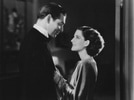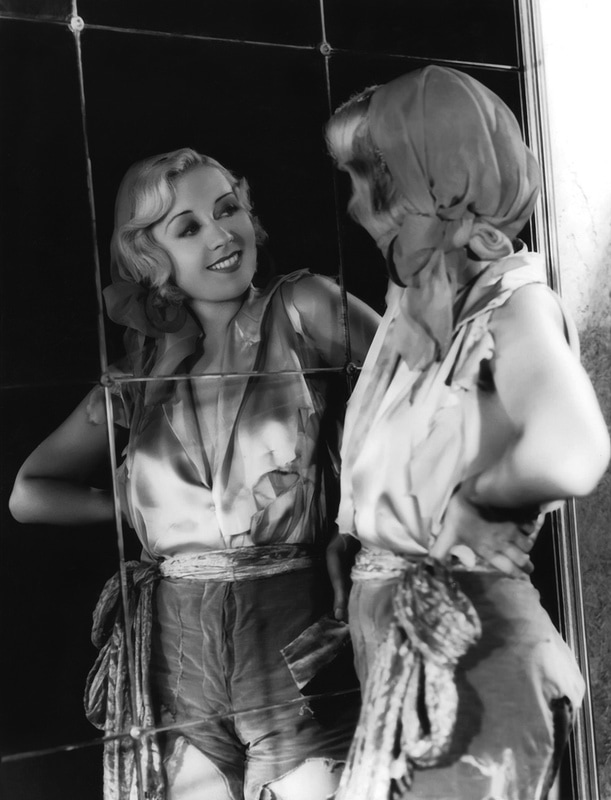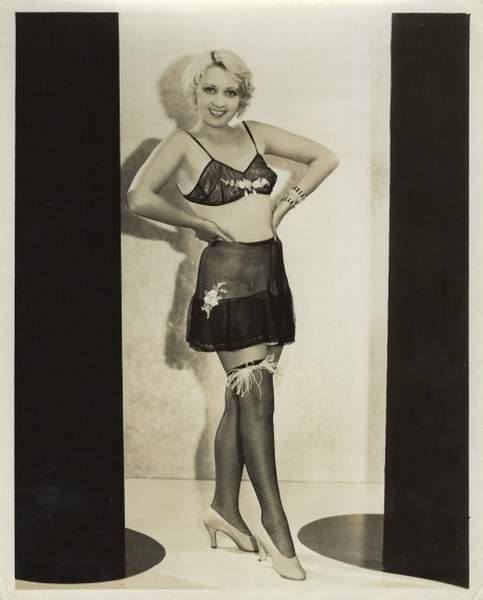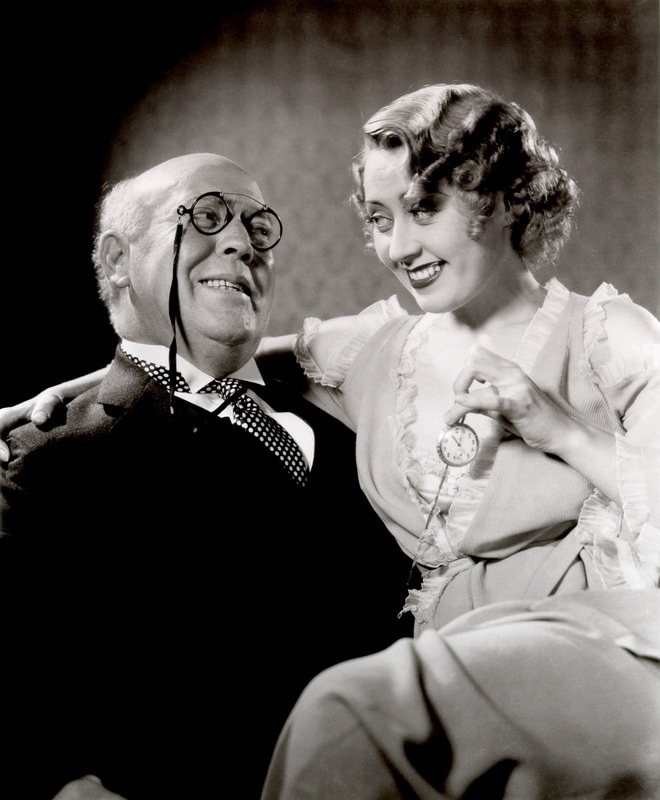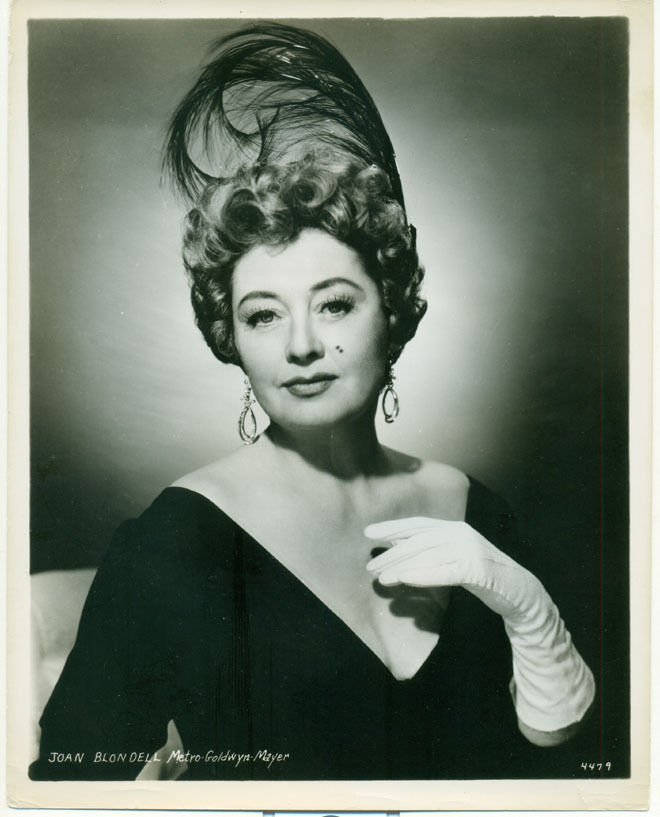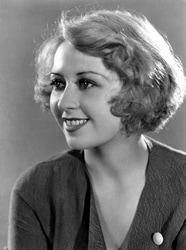Thumbnail Bio: Joan Blondell
Born: 1900 in New York
Died: 1979
John Korbal put it perfectly in his book People Will Talk (Knopf, 1985) when he said, “In the more than 80 films made in a career that spanned more than fifty years, right up to her death, there is no such thing as a Joan Blondell picture, but her image is as strong and enduring as that of any of the great stars of the ‘30’s and the ‘40’s.” (p.181) She was the consummate working actress, often playing the sidekick, best friend or girlfriend. What separated her from most others actors of her generation, however, was her spirit. When she was on screen it appeared that she was someone the audience could relate to, if that person always had the perfect witticism, said in the right way at the right time to the right person. Joan Blondell was an original and her many roles displayed not just hat originality, but her skill as an actress in everything from musicals, to comedies, to dramas & everything in between.
Born into a vaudeville family, Joan was part of the act by the time she was 3 years old. Travelling from town to town, country to country throughout her youth Joan developed her “the show must go on” mentality at the foot of her father. As a teenager she won a beauty contest in Dallas, TX that awarded her $2,000 and a trip to Atlantic City. She placed 2nd in the Southwest Region of the pageant and returned to Dallas. For her trouble she was almost raped, jumping from a moving car & braking an ankle to fend off the attacker. The family moved to New York in 1927 and the entire clan worked whatever jobs were available to make ends meet.
Joan was often auditioning for plays and on one such audition she met James Cagney. Both he and Joan were cast in Maggie the Magnificent, which happened to have the ignominious claim of opening the night of the 1929 stock market crash. Unfortunately, the play closed shortly thereafter, but Cagney & Blondell were then cast in Penny Arcade and were discovered by Al Jolson, who bought the rights to the play. Selling the rights to Warner Bros, Jolson included the stipulation that the 2 stars came with the play, now retitles Sinners Holiday, so Darryl Zanuck agreed to one picture contracts and promptly gave the pair secondary roles. After the first day of shooting it was clear to anyone who had seen the dailies, however, that all the heat was coming from Blondell & Cagney, so Zanuck made the switch & Cagney & Blondell ascended to the top roles.
What followed for Blondell can only be described as an avalanche of performances over the next 8 years, 52 films in total, including another 6 with Cagney, more than any of his other co-stars. Included in the deluge were pre-code classics like Public Enemy with Cagney, as well as Night Nurse, with Barbara Stanwyck & Three on a Match, with Ann Dvorak & Bette Davis. Her Warner contract started out at $250 per week and rose to $1,000 per week by 1934, a period when she made no less than 33 movies. While Cagney famously held out for salary commiserate with his stardom, Blondell was always a company player and never flexed her stardom for more money, a fact that she regretted to a degree later in life. Her belief, bred in vaudeville, was that she was happy to be working and appreciated the steady work when so many others were unemployed. The steady paycheck also came in handy because she was primarily supporting her entire family.
While many of the roles noted above were supporting roles, Joan was able to carve out a level of stardom that was quite unique. Her radiant personality was always such that whatever scene she was in a viewer’s eyes were always meant to follow her. She added humor, wit & an infectious effervescence to every character and performance and as such she was given top billing in films like Blondie Johnson, (the lost) Convention City & Miss Pinkerton. Even in films with Cagney, when most actors shrunk into his shadow, Blondell shined brightly, whether as his love interest/partner in Blonde Crazy or even as a secondary character like in The Crowd Roars.
While the Warner Bros. process of filmmaking in the 1930’s was more akin to a sausage factory than a dream factory, Joan’s versatility shown as she effortlessly moved from comedies to drama and into musicals. With Gold Diggers of 1933 & Footlight Parade Blondell flashed her vaudeville hoofing abilities, as well as the sharp wit that won her fans both male & female. The rendition of Remember My Forgotten Man at the conclusion of Gold Diggers of 1933 is recited/sung by Blondell in a mournful way that gives meaning to and undercuts all that has come before it in the movie. The show stopping tune, depicting all the misery of the depression “…is perhaps the most socially urgent song ever conceived for an American musical film.” (Kennedy, p.55) and Joan’s delivery is every bit as gut wrenching as the images to come. Director Busby Berkeley knew that Blondell couldn’t sing but he felt “she could act it. I knew she could talk it and put over the drama for me.” (Kennedy p. 55)
In addition to Cagney, Joan had several other regular co-stars. The most common was Glenda Farrell, with whom Joan starred in 8 films, generally as wise cracking best friends. Another was Dick Powell, who would become Joan’s second husband. It was never clear when their friendship turned romantic, they had co-starred in both Gold Diggers of 1933 & Footlight Parade together before dating, but by the time they made Colleen together they were definitely an item. In Colleen Dick is romantically paired with Rudy Keeler, as he often was during the ‘30’s, but it was Joan who was his real life soulmate. In fact, Joan later admitted that she got push back from fans who believed that Dick & Ruby’s on-screen romances should be transported to real life. Powell and Blondell were married in September of 1936.
Powell often bristled against his constant casting as a “golly gee” innocent in backstage musicals and wanted more meaty roles. Until he recast his image starring as Phillip Marlowe in 1944’s Murder, My Sweet, he was only known as a song and dance man. Also in 1944, Joan & Powell divorced, having drifted apart after having a daughter together & Dick adopting Joan’s son form her first marriage with cameraman George Barnes. Joan was in New York being courted by her future 3rd husband Mike Todd (later married to Elizabeth Taylor), while Dick was having an affair in LA with June Allyson. They remained friends for their rest of their lives, however.
During the ‘40’s feature film parts were few and far between, with Joan only being credited with 13 movies during the entire decade. A desire for live performance led to touring company & Broadway roles, with film work scattered between. In an odd transition Joan moved far more quickly to more mature character roles than most of her contemporaries. Whether by choice or circumstance, however, most of these roles did nothing to diminish her range or impact as an actress. In fact, 2 of her most memorable roles were released in the ‘40’s, with A Tree Grows in Brooklyn & Nightmare Alley, both released for Fox.
In the ‘50’s she continued to do a lot of theatre, both in the US and in London, as well as mixing in several movie roles, but slowly began a 25 year run as both a regular and guest star on TV shows. In 1952, however, she did receive her only Oscar nomination for The Blue Veil, losing to Kim Hunter in A Streetcar Named Desire.
In the 60’s she appeared in everything from The Lucy Show to The Man from U.N.C.L.E. on TV before earning back to back Emmy nominations for her role as Lottie in Here Come the Brides in 1968 & ’69.
True to her nature Joan continued to perform until she died in 1979 at age 73. One of her final film roles was as the wisecracking waitress Vi in Grease (’78), which is somewhat a fitting end for a true performer and a gifted actress, who was wisecracking until the end.
Born: 1900 in New York
Died: 1979
John Korbal put it perfectly in his book People Will Talk (Knopf, 1985) when he said, “In the more than 80 films made in a career that spanned more than fifty years, right up to her death, there is no such thing as a Joan Blondell picture, but her image is as strong and enduring as that of any of the great stars of the ‘30’s and the ‘40’s.” (p.181) She was the consummate working actress, often playing the sidekick, best friend or girlfriend. What separated her from most others actors of her generation, however, was her spirit. When she was on screen it appeared that she was someone the audience could relate to, if that person always had the perfect witticism, said in the right way at the right time to the right person. Joan Blondell was an original and her many roles displayed not just hat originality, but her skill as an actress in everything from musicals, to comedies, to dramas & everything in between.
Born into a vaudeville family, Joan was part of the act by the time she was 3 years old. Travelling from town to town, country to country throughout her youth Joan developed her “the show must go on” mentality at the foot of her father. As a teenager she won a beauty contest in Dallas, TX that awarded her $2,000 and a trip to Atlantic City. She placed 2nd in the Southwest Region of the pageant and returned to Dallas. For her trouble she was almost raped, jumping from a moving car & braking an ankle to fend off the attacker. The family moved to New York in 1927 and the entire clan worked whatever jobs were available to make ends meet.
Joan was often auditioning for plays and on one such audition she met James Cagney. Both he and Joan were cast in Maggie the Magnificent, which happened to have the ignominious claim of opening the night of the 1929 stock market crash. Unfortunately, the play closed shortly thereafter, but Cagney & Blondell were then cast in Penny Arcade and were discovered by Al Jolson, who bought the rights to the play. Selling the rights to Warner Bros, Jolson included the stipulation that the 2 stars came with the play, now retitles Sinners Holiday, so Darryl Zanuck agreed to one picture contracts and promptly gave the pair secondary roles. After the first day of shooting it was clear to anyone who had seen the dailies, however, that all the heat was coming from Blondell & Cagney, so Zanuck made the switch & Cagney & Blondell ascended to the top roles.
What followed for Blondell can only be described as an avalanche of performances over the next 8 years, 52 films in total, including another 6 with Cagney, more than any of his other co-stars. Included in the deluge were pre-code classics like Public Enemy with Cagney, as well as Night Nurse, with Barbara Stanwyck & Three on a Match, with Ann Dvorak & Bette Davis. Her Warner contract started out at $250 per week and rose to $1,000 per week by 1934, a period when she made no less than 33 movies. While Cagney famously held out for salary commiserate with his stardom, Blondell was always a company player and never flexed her stardom for more money, a fact that she regretted to a degree later in life. Her belief, bred in vaudeville, was that she was happy to be working and appreciated the steady work when so many others were unemployed. The steady paycheck also came in handy because she was primarily supporting her entire family.
While many of the roles noted above were supporting roles, Joan was able to carve out a level of stardom that was quite unique. Her radiant personality was always such that whatever scene she was in a viewer’s eyes were always meant to follow her. She added humor, wit & an infectious effervescence to every character and performance and as such she was given top billing in films like Blondie Johnson, (the lost) Convention City & Miss Pinkerton. Even in films with Cagney, when most actors shrunk into his shadow, Blondell shined brightly, whether as his love interest/partner in Blonde Crazy or even as a secondary character like in The Crowd Roars.
While the Warner Bros. process of filmmaking in the 1930’s was more akin to a sausage factory than a dream factory, Joan’s versatility shown as she effortlessly moved from comedies to drama and into musicals. With Gold Diggers of 1933 & Footlight Parade Blondell flashed her vaudeville hoofing abilities, as well as the sharp wit that won her fans both male & female. The rendition of Remember My Forgotten Man at the conclusion of Gold Diggers of 1933 is recited/sung by Blondell in a mournful way that gives meaning to and undercuts all that has come before it in the movie. The show stopping tune, depicting all the misery of the depression “…is perhaps the most socially urgent song ever conceived for an American musical film.” (Kennedy, p.55) and Joan’s delivery is every bit as gut wrenching as the images to come. Director Busby Berkeley knew that Blondell couldn’t sing but he felt “she could act it. I knew she could talk it and put over the drama for me.” (Kennedy p. 55)
In addition to Cagney, Joan had several other regular co-stars. The most common was Glenda Farrell, with whom Joan starred in 8 films, generally as wise cracking best friends. Another was Dick Powell, who would become Joan’s second husband. It was never clear when their friendship turned romantic, they had co-starred in both Gold Diggers of 1933 & Footlight Parade together before dating, but by the time they made Colleen together they were definitely an item. In Colleen Dick is romantically paired with Rudy Keeler, as he often was during the ‘30’s, but it was Joan who was his real life soulmate. In fact, Joan later admitted that she got push back from fans who believed that Dick & Ruby’s on-screen romances should be transported to real life. Powell and Blondell were married in September of 1936.
Powell often bristled against his constant casting as a “golly gee” innocent in backstage musicals and wanted more meaty roles. Until he recast his image starring as Phillip Marlowe in 1944’s Murder, My Sweet, he was only known as a song and dance man. Also in 1944, Joan & Powell divorced, having drifted apart after having a daughter together & Dick adopting Joan’s son form her first marriage with cameraman George Barnes. Joan was in New York being courted by her future 3rd husband Mike Todd (later married to Elizabeth Taylor), while Dick was having an affair in LA with June Allyson. They remained friends for their rest of their lives, however.
During the ‘40’s feature film parts were few and far between, with Joan only being credited with 13 movies during the entire decade. A desire for live performance led to touring company & Broadway roles, with film work scattered between. In an odd transition Joan moved far more quickly to more mature character roles than most of her contemporaries. Whether by choice or circumstance, however, most of these roles did nothing to diminish her range or impact as an actress. In fact, 2 of her most memorable roles were released in the ‘40’s, with A Tree Grows in Brooklyn & Nightmare Alley, both released for Fox.
In the ‘50’s she continued to do a lot of theatre, both in the US and in London, as well as mixing in several movie roles, but slowly began a 25 year run as both a regular and guest star on TV shows. In 1952, however, she did receive her only Oscar nomination for The Blue Veil, losing to Kim Hunter in A Streetcar Named Desire.
In the 60’s she appeared in everything from The Lucy Show to The Man from U.N.C.L.E. on TV before earning back to back Emmy nominations for her role as Lottie in Here Come the Brides in 1968 & ’69.
True to her nature Joan continued to perform until she died in 1979 at age 73. One of her final film roles was as the wisecracking waitress Vi in Grease (’78), which is somewhat a fitting end for a true performer and a gifted actress, who was wisecracking until the end.
